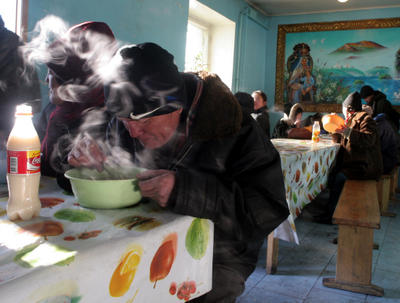Mongolian newspapers have over the years reported rumours that Enkhbayar had enriched himself through shady dealings — yet many government officials have grown wealthy through questionable practices. Although he has now been released on bail after a hunger strike, the question remains: why was Enkhbayar singled out?
Knowledgeable sources attribute this heavy-handed show of government power to politics. Enkhbayar had released documents that appeared to implicate Mongolia’s current president, Tsakhiagiin Elbegdorj, in instigating riots that led to the deaths of five men, who, among others, were protesting against the 2008 parliamentary election results. The detained ex-president had also started a new political party that threatened to draw votes away from the two major parties in the upcoming June 2012 elections. The involvement of Bat Khurts, the deputy director of the Anti-Corruption Agency and formerly head of the Mongolian National Security Council, also cast a negative light on the arrest. Many Mongolians have attributed the use of overpowering force to Khurts, a very shadowy figure.
The foreign advisers and representatives from the Asian Development Bank, IMF and other financial agencies who had touted Mongolia as one of the great successes of the post-Communist world have been embarrassed by these developments. They had conflated democracy and a market economy, and had facilitated what Fortune magazine called ‘Mongolia’s wild ride to capitalism’. This ‘wild ride’ prompted Transparency International to rank Mongolia 120th in terms of perceived public-sector corruption out of the 183 countries surveyed in 2011. A gold- and copper-mining rush has also contributed to cupidity and lawlessness. The government’s sweetheart deals with foreign mining companies, with the attendant corruption and environmental depredation, have plagued the country. Present-day Mongolia is not the success story often portrayed in official reports and in the Western media. And the real story underlying the Enkhbayar incident has been in the making for more than 20 years.
In 1990, Mongolia broke away from communism and turned to international financial agencies for assistance. Handsomely paid representatives and consultants from these agencies began to stream into Mongolia. Ardent believers in the pure market economy, they advocated the immediate privatisation of state assets, limited government and the reduction of services, the elimination of subsidies, the liberalisation of trade and prices, and austerity. In order to obtain essential loans and grants from the international financial institutions, the Mongolian government embarked upon ‘shock therapy’, a rapid implementation of these policies.
A few Mongolians — who understood the operation of a market economy, had influential friends or were corrupt — were the principal beneficiaries of privatisation, while the vast majority of the population gained virtually nothing. As a result, Mongolian society has faced an increasingly inequitable distribution of income. The repercussions of such ‘shock therapy’ persist to the present day. Unemployment has grown to at least 20 per cent of urban residents. Homelessness, alcoholism, crime and domestic abuse have also increased sharply.
The limited government, advocated by supporters of the market economy, is unable to cope with these problems. The social safety net has frayed, leaving many Mongolians vulnerable. Sparse government resources have also translated into a reduction of public expenditure on health, education and welfare, which had been among the successes of the Communist system.
By 1994, representatives of the international financial organisations acknowledged these problems, particularly the sharp rise in poverty. A World Bank study found that 27 per cent of the population lived below the poverty line. In response, the international financial organisations developed a Poverty Alleviation Program and pledged to reduce poverty to 10 per cent by 2000. Instead, a second World Bank study in 1998 found that the number had climbed to 36 per cent. The Poverty Alleviation Program had been inadequately funded and was based on a ‘trickle-down’ philosophy, which emphasised economic growth, not specific aid to the needy, as the solution to poverty.
Herding, formerly the source of livelihood for a third of the population, has encountered problems. The immediate privatisation of herds in the early 1990s benefited a few leaders and the well connected, who laid claim to the old collectives’ animals, trucks and machinery. Poorer herders were left on their own without the earlier support system of free veterinary care, state construction of wells, and transport of animals and animal products to market. Lacking those services, less-fortunate herders have suffered enormously, and many have had to abandon herding and move to slums in an already overcrowded capital city.
The international financial agencies have presented an all-too-rosy picture of the country. Mongolia has had relatively free elections since 1990, but economic democracy has been ignored. Corruption and growing economic inequality, both revealed by the Enkhbayar incident, do not bode well for the future of democracy in Mongolia.
Morris Rossabi is Distinguished Professor of History at the City University of New York and Adjunct Professor of Inner Asian History at Columbia University.

